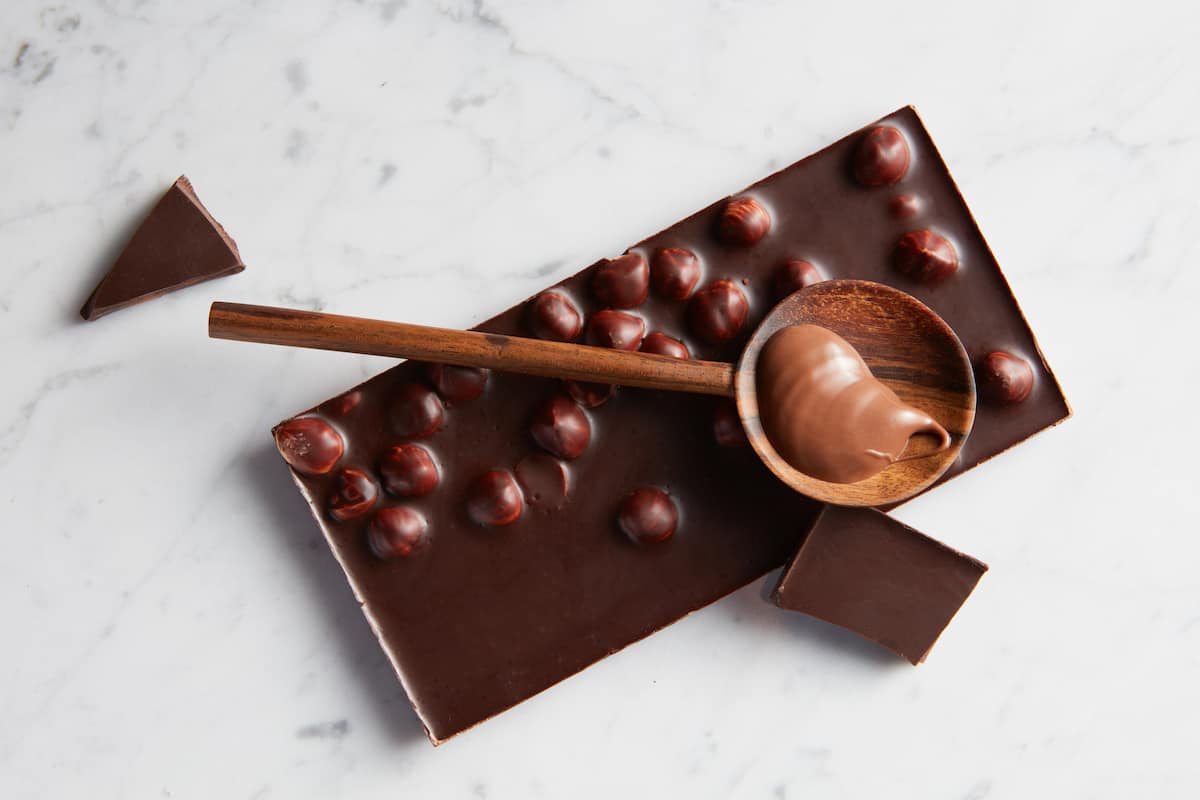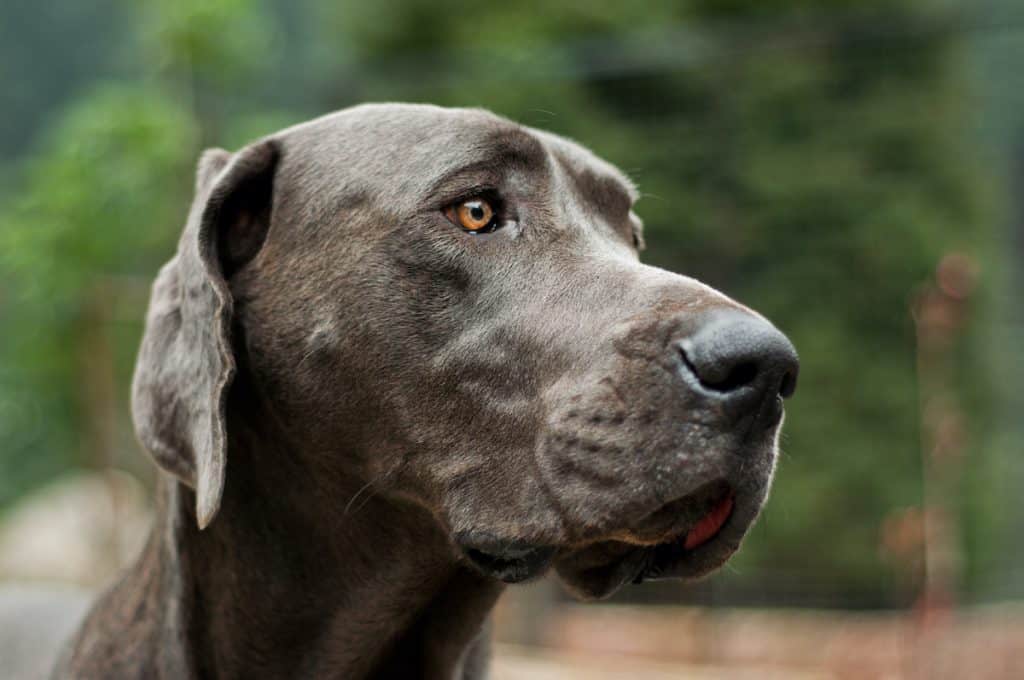
We get it – you love your Great Dane, and you also love chocolate. You wouldn’t be the only one! However, you likely know that dogs and chocolate don’t mix – and you probably want to know what to do and when to be concerned if your Great Dane eats some of your chocolate.
What should you do if your Great Dane eats chocolate? If your Great Dane eats chocolate, you should:
- Immediately try to find out how much and what kind they ate
- Monitor for any signs of toxicity
- Call the Pet Poison Hotline and/or your Great Dane’s veterinarian
- Follow the Pet Poison Hotline’s and your veterinarian’s advice
To help you be prepared in the event your Great Dane eats chocolate, we’ll walk you through why chocolate is in fact so toxic to dogs.
We will also fill you in on the actions you need to take if your Great Dane eats chocolate, and how to prevent them from eating chocolate in the future.
Help! My Great Dane Ate Chocolate

Dogs have a knack for putting things in their mouths that don’t belong there…
Considering the ASPCA Animal Control Center handled 21,585 chocolate-related cases in 2018 alone! Dogs especially have a knack for getting ahold of this delicious treat (source).
If your Great Dane ate some chocolate, here’s what you should do.
Find Out How Much and What Type He Ate
As soon as you know your Great Dane has consumed chocolate, it’s of utmost importance to find out how much he ate and what kind he ate.
The amount and type of chocolate consumed by a dog will determine if the situation is an emergency or not.
You may have caught your Great Dane right in the act of eating chocolate, and therefore know how much he consumed. On the other hand, you may have to deduce how much chocolate your dog ate by the number of wrappers left behind.
While it can be tough to gauge an exact amount of how much chocolate was consumed, try to be as accurate as you can!
Why Amount and Type Matters
Chocolate is toxic to dogs because it contains caffeine and theobromine. Both of these substances stimulate the nervous systems and accelerate the heart rates of dogs, which can lead to many undesirable (and even lethal) health effects.
However, what most people don’t realize is that different types of chocolate contain varying amounts of caffeine and theobromine.
Because of this, the type of chocolate, how much was eaten, and the dog’s weight are all factors that determine the dog’s risk of becoming sick.
These types of chocolate are listed in order of highest theobromine content:
- Cocoa powder
- Unsweetened baker’s chocolate
- Semisweet chocolate
- Dark chocolate
- Milk chocolate
Cocoa powder is the most toxic to dogs, followed by unsweetened baker’s chocolate. Milk chocolate contains the least amount of theobromine and is, therefore, a bit less toxic than other types of chocolate.
According to the American Kennel Club, a concerning dose of chocolate for a dog is about one ounce of milk chocolate per pound of body weight (source).
Great Danes and Chocolate
Since Great Danes are so large – weighing anywhere from 110 to 175 pounds on average – they can get away with eating small amounts of chocolate with less risk for toxicity compared that those of smaller dogs.
This isn’t to say that chocolate is good for them, just that their large size helps to act as a buffer.
It can take a relatively large amount of theobromine to cause a toxic reaction in a Great Dane – around 100 to 150 mg of theobromine per kilogram (about 2.2 pounds). For reference, one ounce of milk chocolate typically has 44 mg of theobromine.
However, chocolate can still do damage, and you should be concerned if your dog consumes chocolate.
If you know your Great Dane’s weight and how much and what type of chocolate your Great Dane consumed, you can plug the information into PetMD’s Chocolate Toxicity Meter for Dogs to see just how toxic the chocolate could be.
Monitor for Signs of Chocolate Toxicity
Immediately after discovering that your Great Dane ate chocolate, you should begin monitoring him for signs of chocolate toxicity.
Signs of chocolate toxicity include:
- Restlessness
- Excessive drooling
- Excessive thirst
- Abdominal pain or discomfort
- Vomiting
- Vomiting with blood
- Increased rate of breathing
- Difficulty standing or walking
- Tremors
- Collapse
Symptoms of chocolate toxicity usually arise within a few hours of the dog consuming chocolate. However, symptoms can be delayed for up to 24 hours.
Monitoring your Great Dane for any symptoms or signs of chocolate toxicity can be a matter of life and death in a lot of cases. Make sure to keep a very close eye on your pup!
Call the Pet Poison Control Hotline and/or Your Great Dane’s Veterinarian

When in doubt – or even when concerned at all – consult the experts!
If your Great Dane has eaten chocolate, there are two great places to start to consult the experts: the Pet Poison Control Hotline and your Great Dane’s veterinarian.
The Pet Poison Control Hotline number is 855-213-6680.
The representative on the hotline will likely ask you if you know how much chocolate your Great Dane consumed, what type the chocolate was, and how much your Great Dane weighs.
The hotline can give you advice on toxicity levels and whether to consult your dog’s veterinarian.
However, it’s still smart to consider consulting your Great Dane’s veterinarian even if you’ve already contacted the hotline. Your veterinarian may recommend you monitor your dog for the symptoms listed above.
In some cases, veterinarians may advise you to induce vomiting in your Great Dane with a specific amount of 3% hydrogen peroxide.
While vomiting can help get rid of the consumed chocolate, some of the theobromine still could have been absorbed by your Great Dane’s body. Because of that, your vet might want to see your dog.
Tips for Preventing Your Great Dane from Eating Chocolate
Great Dane owners that are also chocolate lovers just want to be able to eat their M&Ms or Hershey’s Bars in peace – without having to worry that their dog’s health is at risk.
The best way to be able to do that is to prevent your Great Dane from eating chocolate in the first place.
Knowing that this may be easier said than done, here are a few ways to approach it.
#1 – Teach the “Leave It” Command
The “Leave It” command can help you out a lot if you catch your Great Dane in the act of eating chocolate.
Teaching your Great Dane how to “Leave It” can allow you to tell him the command when he’s about to eat chocolate or has chocolate in his mouth. That way, you can hastily pick up the chocolate and get it away from him!
#2 – Keep the Chocolate Out of Reach
The easiest way to prevent your Great Dane from eating chocolate is to keep it out of reach.
Knowing that Great Danes are tall and can rest their heads on most kitchen counters, you’ll need to be extra mindful of where you leave any! You may have to get crafty with where you keep your chocolate.
It may have to be stored in a very high cupboard or even a locked drawer.
Either way, at least you won’t have to feel guilty about hiding your chocolate. After all, it’s for your Great Dane’s benefit!
Final thoughts on Great Danes Eating Chocolate
Great Danes are large dogs – weighing in at anywhere from 110 to 175 pounds. Because of their size, it can take quite a bit of chocolate to induce chocolate toxicity in Great Danes.
That being said, it’s still dangerous for dogs to consume chocolate in any amount.
If your Great Dane has eaten chocolate, stay calm, find out how much and what type of chocolate he ate, monitor him for signs of chocolate toxicity, and consult the experts – the Pet Poison Control Hotline and your dog’s veterinarian.
Don’t feel guilty – you can still have your chocolate treats around. Just make sure to prevent your Great Dane from eating them!
In addition to your Great Dane eating chocolate, you may also wonder about your Great Dane eating other strange things like milk, poop, and grass. All of which are linked for your review!
